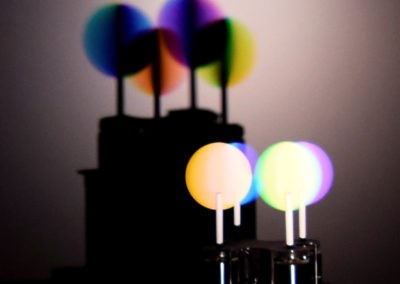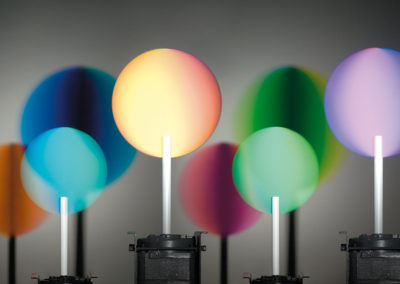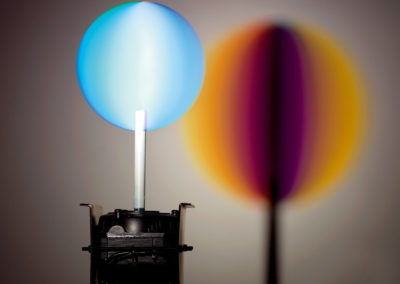MECHANICAL PRISM (1967)
This consists of a Synthetic Light projector and a white, vertical, disc-shaped aluminium support rotating at high speed, which collects and reflects the light, breaking it down into its constituent colours. The white disc (the “mechanical prism”) turns orange, purple, green, blue, with a gradual transition from one colour to the next. So the white disc will appear to be a small ball suspended from a white bar composed of continuously changing colours. The observer seems to be looking at a sphere of coloured air. The rotation produces an exhalation and a hiss that accentuate the sensation of immateriality.
Looking at the shadow of the prism projected on the backdrop, such as a white wall, a similar continuously changing colour sequence occurs. This time, the type of colouring on the two-dimensional surface is similar to that on the rotating vertical disk, but the colours that appear are complementary to those reflected by the prism.
Synthetic Light (1965)
During the 1960s, Fogliati worked on the development of his urban projects. He wanted to introduce aesthetic presences into the environment and to act on atmospheric events in unusual ways. One of these was the colouring of rain.
Instead of trivialising the idea with simple beams of coloured light, Fogliati intended to create a truly unusual event with a light that “behaved in a ‘particular’ way”. In the mid-1960s, he designed and produced a type of light he called Luce Sintetica, Synthetic Light, or Luce Fantastica, Fantastic Light.
When the light is used to illuminate a motionless object, the beam appears to be white. When the light illuminates a moving object, then it breaks down into its constituent colours. In other words, the distinctive feature of this type of light is its ability to adapt to the characteristics of the object it illuminates. Fogliati realised that when a beam of Synthetic Light was projected on a moving object, the object would be coloured by the colours of the beam. This is what he wanted to do with rain, and he demonstrated the idea with the Prisma meccanico, the Rivelatore cromocinetico and the Svolazzatore cromocangiante.



